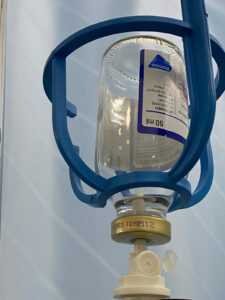Poly MVA is a uniquely formulated combination of minerals, vitamins and amino acids designed to support cellular energy production and promote overall health. The physicians at Sunridge Medical find it is a very important component in the treatment of mitochondrial dysfunction, which is at the root of most cancers. With over 15 years of clinical laboratory research and testing, Poly-MVA is a revolutionary product based on patented lipoic acid-palladium complexes (LAPd).

Poly MVA Benefits
Poly-MVA maintains and enhances the function of mitochondria, the main source of energy within cells. Poly-MVA not only protects healthy cells using aerobic respiration from damage but also enhances their function and action. The clinical effects of Poly-MVA is part of our Cancer Care and has been proven successful treatment in laboratory studies with countless patients, as well as in doctor’s clinics and hospitals nationwide.
Poly MVA Benefits
Poly-MVA maintains and enhances the function of mitochondria, the main source of energy within cells. Poly-MVA not only protects healthy cells using aerobic respiration from damage but also enhances their function and action. The clinical effects of Poly-MVA is part of our Cancer Care and has been proven successful treatment in laboratory studies with countless patients, as well as in doctor’s clinics and hospitals nationwide.
Research on Poly MVA
Lieberman, Shari and Forsythe, James W.Poly MVA for Treating Non–Small-Cell Lung Cancer: A Case Study of an Integrative Approach, Alternative and Complementary Therapies 2 77-80 2006 ,10.1089/act.2006.12.77 https://doi.org/10.1089/act.2006.12.77 https://doi.org/10.1089/act.2006.12.77 We investigated the dietary supplement Poly MVA as an integrative treatment for a patient diagnosed with advanced stage 4 non–small-cell lung cancer (NSCLC). Despite multidrug resistance, the patient continued to have a good quality of life and did well on a performance scale score. The addition of Poly MVA to her therapeutic protocol may have allowed her to feel well despite clinical failure as evidenced by rising tumor markers. Approximately 2 years after diagnosis she responded to an older chemotherapeutic regimen of 5′–fluorouracil (5FU) and mitomycin-C while taking Poly MVA.
She had an excellent clinical response as confirmed by significant clinical improvement on a computed tomography scan. Her last tumor marker levels were significantly decreased, with her carcinoembryonic antigen (CEA) level slightly elevated at 5.5 (normal is < 3.1 ng/mL) and her CA 19-9 normal at 16.7 (normal is < 30 µ/mL). She continues to have a good quality of life, does well on the performance scale, feels well, and remains on Poly MVA. After providing background on NSCLC and pharmaceuticals and on Poly MVA, we describe the patient’s treatment with this supplement and her response to it.
Menon, Aditya and Krishnan, Chirakkal V. and Nair, Cherupally Krishnan Krishnan, Protection from gamma-radiation insult to antioxidant defense and cellular DNA by POLY MVA, a dietary supplement containing palladium-lipoic acid formulation, journal = International Journal of Low Radiation 6 ,3 248-262 2009,10.1504/IJLR.2009.028892 https://www.inderscienceonline.com/doi/pdf/10.1504/IJLR.2009.028892 Whole-body exposure to gamma radiation was found to result in damage to cellular DNA and lowering of antioxidant levels in various tissues. Administration of POLY MVA, a palladium-lipoic acid formulation, for seven days prior to whole-body gamma radiation significantly reduced the damage to cellular DNA in bone marrow and blood leukocytes, as well as preventing the radiation-induced lowering of tissue antioxidant levels.doi:10.1089/act.2005.11.203,Lieberman, Shari and Forsythe, James W.,
Poly MVA for Treating Prostate Cancer: A Report on Three Cases, Alternative and Complementary Therapies,11,4,203- 07,2005,10.1089/act.2005.11.203, PMID:15750382, https://doi.org/10.1089/act.2005.11.203 Regulation of ischemic cell death by the lipoic acid–palladium complex, Poly MVA, in gerbils, Experimental Neurology,189,1, 10-15,2004,2014-488 https://doi.org/10.1016/j.expneurol.2004.05.011,
https://www.sciencedirect.com/science/article/pii/S0014488604001852, Francis J. Antonawich and Susan M. Fiore and Lauren M. Welicky,Poly MVA, DNA Reductase, Hippocampus, CA1, Transient ischemia, Modulation of ischemic cell death can be accomplished via a multitude of mechanisms, such as quenching radical species, providing alternative energy sources, or altering glutamate excitation. Transient cerebral ischemia will induce apoptotic cell death selectively to hippocampal cornus ammon’s field 1 of the hippocampus (CA1) pyramidal cells, while neighboring CA3 and dentate neurons are spared.
Poly MVA Enhance Radiation Therapy
Poly-MVA enhanced the antitumor effect of radiation when administered beforehand. Furthermore, Poly-MVA administered once daily for 2 weeks, immediately after 4 Gy irradiation, protected DNA damage in peripheral blood. It also rendered protection against the radiation-induced reduction of platelet count.
The unique electronic and redox properties of the palladium-α-lipoic acid complex in Poly-MVA appear to be responsible for the exhibited effect. The results conclude that the antitumor-enhancing and normal cell-protective effect of Poly-MVA warrants additional studies for its potential clinical application.
For answers or to make an appointment, call us toll-free at 800-923-7878 to speak with a Patient Care Team.
Recover your vitality, reclaim your energy and rediscover your health.

